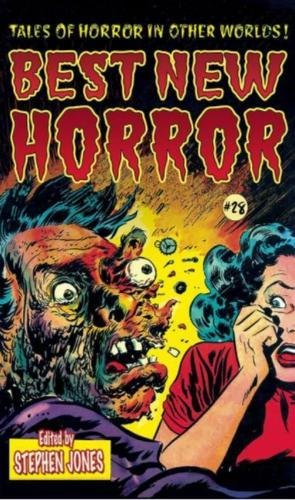Book Review: Best New Horror #28 edited by Stephen Jones
It says something about the number of books published every year, even in this “print is dead” time, that this is the first time I have seen an installment of this British-published horror anthology. Number twenty-eight! Admittedly, my attention was first grabbed by the gruesome and not at all new cover, first used by EC Comics’ Tomb of Terror in 1954, a strong contrast to the more sedate covers favored in the modern day.

The introduction is nearly a hundred pages long, listing the horror and horror-adjacent products that came out in 2016, sometimes with the editor’s opinion attached. It’s an exhausting but not exhaustive list (live-action Japanese monster movies are included, but not manga or anime.) The intro ends with a bewailment of the current publishing industry, but at least that isn’t in the “Necrology” section at the end, which lists all the horror and horror-adjacent people who died in 2016 and is a terrifyingly long list.
But there’s still room in this thick volume for 23 stories. As one might guess from the editor’s nationality, there’s an emphasis on British authors.
First up is “Pale Tree House” by Angela Slatter. Mr. Anderson fetches orphans from the orphanage for a very particular client. Today’s orphan looks familiar, but Mr. Anderson shrugs that off. After all, he never picks up the same orphan twice. Then comes the dawn….
Last in the order is “The Red Forest” also by Angela Slatter. Dina is the last survivor of an Eastern European village ravaged by disease and war. A bargain was made to preserve her life, too late for the other villagers, or perhaps too soon. I liked this one much better, but then I have a fondness for Baba Yaga stories.
In between, stories I especially liked included “India Blue” by Glen Hirshberg, in which an attempt at bringing professional league cricket to California fails in an unexpected way; “Princess” by Dennis Etchison, about a family on their way to Princess Land with a reluctant daughter; and “On These Blackened Shores of Time” by Brian Hodge, a Lovecraftian tale about sinkholes and mining history.
I don’t recall any actively bad stories, but a few were forgettable enough that I have forgotten which ones they were.
Most of the introductions include how the author got the inspiration for the story. It’s fascinating seeing how some are very directly related, while others spun an entire story off what seems a tiny hint.
The book finishes with a list of useful addresses for those who want to explore contemporary horror literature in more detail, or might get published in the field.
As I have mentioned before, the horror genre is very much a matter of individual taste; I recommend this book to horror fans but you might want to see if your library has it to skim through first.

